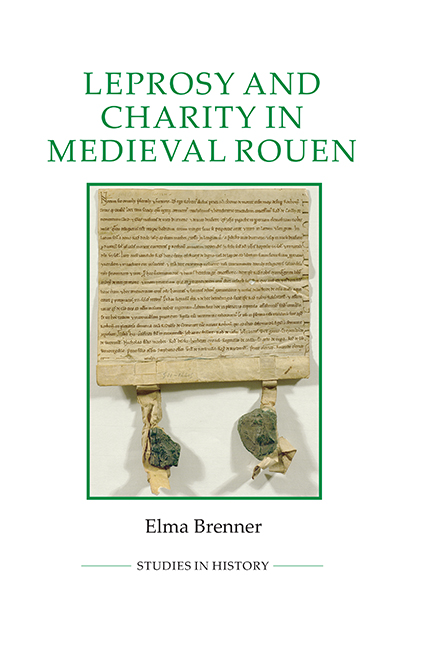Book contents
- Frontmatter
- Dedication
- Contents
- List of Illustrations
- Acknowledgements
- Abbreviations
- Introduction: Leprosy, Charity and Rouen
- 1 Rouen’s Principal Leper House: Mont-aux-Malades and Its Endowment
- 2 Charity and Community at Mont-aux-Malades
- 3 Rouen’s Other Leper Houses: Institutions, Gender and Status
- 4 Leprosy and the Medical World of Rouen
- 5 Leprosy and the Religious Culture of Rouen
- Conclusion
- Appendix 1 A Note on Sources
- Appendix 2 Charters and other Documents Relating to Leprosy in Rouen, c. 1100–c. 1500
- Bibliography
- Index
- Frontmatter
- Dedication
- Contents
- List of Illustrations
- Acknowledgements
- Abbreviations
- Introduction: Leprosy, Charity and Rouen
- 1 Rouen’s Principal Leper House: Mont-aux-Malades and Its Endowment
- 2 Charity and Community at Mont-aux-Malades
- 3 Rouen’s Other Leper Houses: Institutions, Gender and Status
- 4 Leprosy and the Medical World of Rouen
- 5 Leprosy and the Religious Culture of Rouen
- Conclusion
- Appendix 1 A Note on Sources
- Appendix 2 Charters and other Documents Relating to Leprosy in Rouen, c. 1100–c. 1500
- Bibliography
- Index
Summary
This study has charted the impact of, and changing responses to, a distinctive disease, leprosy, in one of the major cities of medieval Western Europe. Its findings are based upon the contents of a remarkable archive, that of the leprosarium of Mont-aux-Malades, one of the largest and wealthiest of such institutions in medieval France. By placing Mont-aux-Malades in the context of other leper houses and sources of evidence, the findings provide the first wide-ranging study of leprosy and charity in Rouen between the central and later Middle Ages, and shed much light on practices of charity, lay piety and property ownership in and around the city. This study also helps us to understand the dynamics and complexities of medieval society during a period of great change, under the stresses of economic growth, plague and war.
Although very few medieval people actually contracted leprosy, the disease had a significant cultural impact throughout Europe. Many factors shaped the experiences of those who suffered from it, as well as responses to it. Gender and social status played a significant role, as is revealed by the history of Rouen's female leper house, Salle-aux-Puelles, while an examination of medical responses sheds new light on the medical world of Rouen and other cities. What is clear, however, is that although responses to leprosy remained diverse and complex throughout the period, with instances of compassion towards sufferers evidenced well into the sixteenth century, there was a fundamental shift in attitudes during the fourteenth century. At that point, concern increased about the spread of disease via corrupt air, and charity for lepers ceased to be highly fashionable.
Lepers: the fine line between marginality and integration
A core issue is the extent to which leprosy sufferers at Rouen were marginalised or excluded, and how this situation changed over time. Here, in providing a new regional case study, this study makes a vital contribution to our understanding of medieval leprosy. The positioning of Rouen's leprosaria outside the city, as was the case for other Western European urban centres, undoubtedly signifies the spatial marginality of the residents of these institutions, and could suggest that an impulse to distance and confine lepers helped to motivate charity for them.
- Type
- Chapter
- Information
- Leprosy and Charity in Medieval Rouen , pp. 132 - 138Publisher: Boydell & BrewerPrint publication year: 2015

